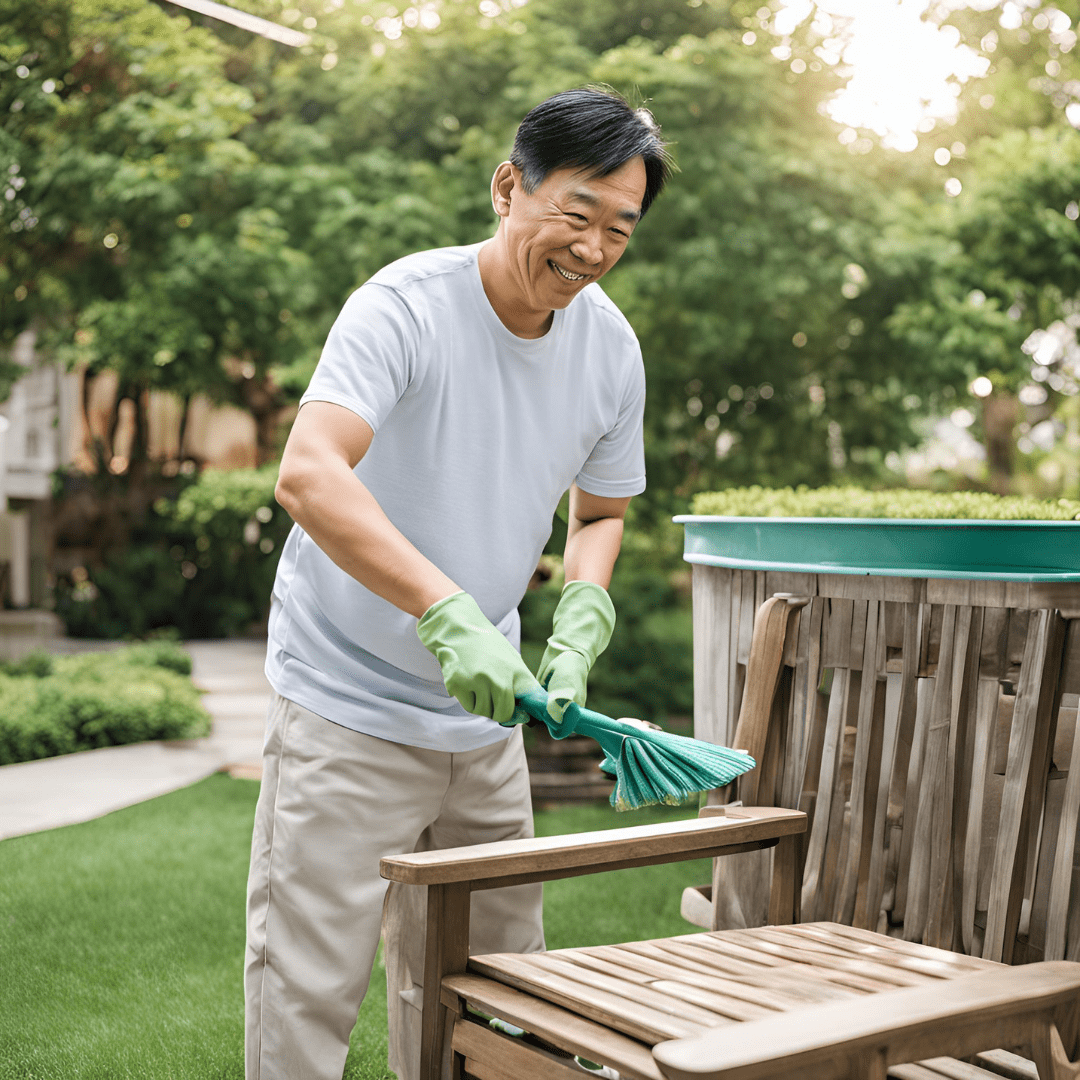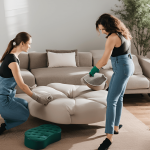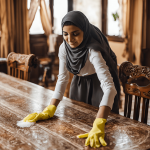
Do you know How To clean lawn furniture? use a mild soap and water solution. Scrub gently with a soft brush and rinse thoroughly.
Maintaining clean lawn furniture ensures it looks good and lasts longer. Dirt, grime, and weather elements can damage outdoor furniture over time. Regular cleaning helps preserve the material and keeps it inviting for use. Different materials like wood, metal, and plastic require specific care techniques.
Using the right cleaning products and methods prevents damage and enhances durability. Always check manufacturer guidelines for specific cleaning instructions. Effective cleaning improves appearance and extends the life of your lawn furniture. Regular maintenance is key to enjoying your outdoor space comfortably. Simple, consistent care can make a significant difference.
Choosing The Right Cleaning Method
Cleaning lawn furniture can seem like a daunting task, but choosing the right cleaning method makes it much easier. The key is to tailor your approach to the specific needs of your furniture. Understanding the material and dirtiness level helps select the best cleaning techniques. Let’s break it down step by step.
Identifying The Material
Before diving into cleaning, first, identify the material of your lawn furniture. This step is crucial because different materials require different cleaning methods. Here are some common materials and their cleaning needs:
- Plastic: Plastic furniture is durable and easy to clean. A mild soap and water solution works wonders.
- Metal: Metal furniture, like aluminum or wrought iron, often needs a rust-preventive cleaner. Avoid harsh chemicals.
- Wood: Wooden furniture can be delicate. Use a gentle cleaner and avoid soaking the wood to prevent damage.
- Fabric: For cushions and fabrics, check the label. Some are machine washable, while others need spot cleaning with a fabric cleaner.
Here’s a quick reference table for identifying the best cleaning methods based on material:
| Material | Best Cleaning Method |
|---|---|
| Plastic | Soap and water |
| Metal | Rust-preventive cleaner |
| Wood | Gentle cleanser |
| Fabric | Spot clean or machine wash |
Determining The Level Of Dirtiness
After identifying the material, assess how dirty your lawn furniture is. This helps in choosing the right cleaning intensity. Here’s how to determine the level of dirtiness:
- Light Dirt: If your furniture just has some dust or light stains, a simple wipe down with a damp cloth is enough.
- Moderate Dirt: For moderate dirt, use a mild soap solution. Scrub gently with a soft brush or sponge.
- Heavy Dirt: If your furniture is heavily soiled, you may need a stronger cleaner. Consider using a power washer for stubborn grime.
To make it easier, here’s a table summarizing the cleaning methods based on the level of dirtiness:
| Level of Dirtiness | Cleaning Method |
|---|---|
| Light | Damp cloth wipe down |
| Moderate | Mild soap solution and gentle scrub |
| Heavy | Stronger cleaner or power washer |
Following these steps ensures your lawn furniture stays clean and lasts longer. Remember, the right cleaning method not only removes dirt but also protects the material.
Cleaning Wooden Furniture
Cleaning lawn furniture is essential to keep it looking great and prolong its life. Wooden furniture, in particular, needs special care to maintain its natural beauty. Here’s a step-by-step guide on how to clean wooden lawn furniture effectively.
Removing Dust And Debris
Start by removing dust and debris from your wooden furniture. Dust can scratch the surface if not removed properly.
Follow these steps:
- Use a soft brush or cloth to gently sweep off loose dirt and dust.
- Vacuum the furniture using a brush attachment to get into crevices and corners.
- Inspect the furniture for any stuck-on debris or cobwebs.
If you encounter stubborn dirt, try these methods:
- Use a soft-bristled brush to gently scrub away the grime.
- For tight spots, use a toothbrush to reach narrow spaces.
Properly removing dust and debris ensures the next steps are more effective and safe for the wood.
Using Mild Soap And Water
After removing the dust, clean your wooden furniture with mild soap and water. Avoid harsh chemicals that can damage the wood.
Follow these steps:
| Step | Action |
|---|---|
| 1 | Mix a few drops of mild dish soap with warm water. |
| 2 | Dip a soft cloth or sponge into the soapy water. |
| 3 | Wipe down the furniture, following the grain of the wood. |
| 4 | Rinse the cloth frequently to avoid spreading dirt. |
| 5 | Use a clean, damp cloth to wipe away any soap residue. |
Always dry the furniture thoroughly with a soft towel to prevent water damage.
Applying Wood Protector
Applying a wood protector helps safeguard your wooden furniture from the elements and extends its life.
Here’s how to apply a wood protector:
- Select the right product: Use a wood protector suitable for outdoor furniture.
- Read the instructions: Follow the product guidelines for best results.
- Apply evenly: Use a clean cloth or brush to spread the protector over the entire surface.
- Work in sections: Ensure even coverage and avoid missing spots.
Allow the protector to dry completely before using the furniture.
Regularly applying a wood protector helps maintain the furniture’s appearance and protects it from weather damage.
Cleaning Metal Furniture
Keeping your lawn furniture clean ensures it lasts longer and looks great. Cleaning metal furniture can be a bit tricky due to rust and tarnish. Follow these steps to keep your metal furniture looking new.
Removing Rust
Rust can ruin the appearance of metal furniture. It’s important to remove it as soon as you see it.
Here are some steps to remove rust effectively:
- Inspect the Furniture: Look for any rust spots on the metal furniture.
- Use Sandpaper or a Wire Brush: Rub the rusted areas with sandpaper or a wire brush. This will remove the loose rust.
- Apply a Rust Remover: Use a commercial rust remover. Follow the instructions on the label.
- Rinse and Dry: Rinse the furniture with water and dry it completely with a clean cloth.
Here is a quick reference table for rust removal tools:
| Tool | Usage |
|---|---|
| Sandpaper | Rub rusted areas |
| Wire Brush | Scrape off loose rust |
| Rust Remover | Apply to rust spots |
Using Vinegar Solution
Vinegar is a natural cleaner that works wonders on metal furniture. Follow these steps to clean your furniture with a vinegar solution:
- Mix the Solution: Combine equal parts of white vinegar and water in a spray bottle.
- Spray the Solution: Spray the vinegar solution on the metal surfaces.
- Let it Sit: Allow the solution to sit for about 10 minutes.
- Scrub with a Sponge: Use a sponge to scrub the furniture gently. This will remove dirt and any remaining rust.
- Rinse and Dry: Rinse the furniture with clean water and dry it with a cloth.
Using vinegar not only cleans but also helps prevent future rusting. It’s an eco-friendly option that is safe for your family and pets.
Polishing The Surface
Polishing metal furniture gives it a shiny, new look. Follow these steps for a polished finish:
- Choose a Metal Polish: Select a metal polish suitable for your furniture. Read the label for instructions.
- Apply the Polish: Apply a small amount of polish to a clean cloth.
- Buff the Surface: Rub the polish onto the metal surface in circular motions.
- Remove Excess Polish: Use another clean cloth to wipe off any excess polish.
- Inspect the Furniture: Check for any missed spots and polish again if needed.
Here’s a simple table to choose the right metal polish:
| Metal Type | Polish Type |
|---|---|
| Aluminum | Non-abrasive polish |
| Iron | Rust-inhibiting polish |
| Stainless Steel | Stainless steel polish |
Polishing not only enhances the look but also provides a protective layer against rust and tarnish.
Cleaning Plastic Furniture
Cleaning lawn furniture is essential to keep your outdoor space inviting and looking great. Plastic furniture is popular because it’s lightweight and durable. However, it can get dirty quickly. Here’s how to clean plastic furniture effectively and keep it looking new.
Wiping With Soapy Water
Start by wiping your plastic furniture with soapy water. This method is simple yet effective.
Follow these steps:
- Fill a bucket with warm water.
- Add a few drops of mild dish soap.
- Dip a soft cloth or sponge into the soapy water.
- Wipe down the entire surface of the furniture.
Focus on all areas, especially the crevices where dirt can hide. For stubborn spots, use a soft-bristled brush. Avoid using abrasive cleaners as they can scratch the plastic.
After cleaning, rinse the furniture with clean water. Use a garden hose to remove all soap residue. Let the furniture air dry or wipe it with a clean towel.
Removing Stains With Baking Soda
Stubborn stains on plastic furniture can be a challenge. Baking soda is an excellent stain remover.
Follow these steps:
- Make a paste by mixing baking soda with a small amount of water.
- Apply the paste to the stained areas using a sponge or cloth.
- Gently scrub the stains in a circular motion.
Let the paste sit for a few minutes. This helps break down the stains. Rinse the area thoroughly with water. If the stain persists, repeat the process.
For extremely tough stains, you can also try a vinegar and water solution. Mix equal parts of vinegar and water, apply it to the stain, and scrub gently.
Applying A Protective Coat
To keep your plastic furniture looking new, apply a protective coat. This helps prevent dirt buildup and UV damage.
Here’s how:
- Ensure the furniture is clean and dry.
- Use a plastic furniture cleaner or a UV-protectant spray.
- Apply the product evenly over the entire surface.
Using a soft cloth, buff the surface to enhance the shine and protection. This protective coat acts as a barrier against dirt and the sun’s harmful rays.
Reapply the protective coat every few months. This ensures long-lasting protection and maintains the furniture’s appearance.
Cleaning Wicker Furniture
Cleaning wicker furniture can be a simple and rewarding task. Wicker furniture is elegant and adds charm to any outdoor space. It requires proper care to keep it looking its best.
Follow these steps to ensure your wicker furniture remains clean and beautiful:
Brushing Off Loose Dirt
Start by brushing off loose dirt. Use a soft-bristle brush for this task. Gently brush the surface to remove dust and debris. Make sure to reach the crevices and corners.
- Use a soft-bristle brush.
- Brush gently to avoid damaging the wicker.
- Focus on crevices and corners.
Brushing off loose dirt helps prevent scratches. It also makes the next steps easier. Regular brushing keeps your furniture looking fresh.
Using A Vacuum Cleaner
Next, use a vacuum cleaner to remove finer dust particles. Attach the brush nozzle for this task. This ensures thorough cleaning without damaging the wicker.
- Attach the brush nozzle to the vacuum cleaner.
- Gently vacuum the wicker surface.
- Pay attention to hard-to-reach areas.
Vacuuming helps in removing dirt that brushing cannot. It is useful for intricate wicker patterns. Regular vacuuming keeps your furniture in pristine condition.
Cleaning With Mild Detergent
Finally, clean the wicker with a mild detergent solution. Mix a small amount of detergent with warm water. Use a soft cloth or sponge for this task.
- Mix mild detergent with warm water.
- Dip a soft cloth or sponge in the solution.
- Gently wipe the wicker surface.
Rinse the cloth and wipe again to remove the soap residue. Allow the furniture to dry completely. This step ensures deep cleaning without harming the wicker.
By following these steps, your wicker furniture will look clean and inviting. Regular maintenance will prolong its life and beauty.
Cleaning Cushions And Fabrics
Cleaning lawn furniture keeps your outdoor space inviting and comfortable. Cushions and fabrics often attract dirt and stains. This section will guide you through the steps to clean them properly.
Vacuuming And Spot Cleaning
Start by vacuuming the cushions and fabrics to remove loose dirt and debris. Use a vacuum cleaner with a brush attachment for best results. This step helps prevent dirt from embedding deeper into the fabric.
Next, spot and clean any visible stains. Here’s how to do it:
- Mix a small amount of mild detergent with water.
- Dip a soft cloth or sponge into the solution.
- Gently blot the stain, avoiding harsh scrubbing.
- Rinse the area with clean water.
- Pat dry with a clean towel.
Regular vacuuming and spot cleaning can keep your cushions looking fresh and extend their life.
Washing Removable Covers
If your cushions have removable covers, washing them becomes easier. Check the care label for specific washing instructions. Most covers are machine washable.
Follow these steps:
- Remove the covers from the cushions.
- Pre-treat any stains with a stain remover.
- Place the covers in the washing machine.
- Use a gentle cycle with cold water and mild detergent.
- Air dry the covers to prevent shrinking.
Washing the covers regularly keeps them clean and free from odors. Make sure the covers are completely dry before putting them back on the cushions.
Treating Stubborn Stains
For stubborn stains that don’t come off with spot cleaning, try the following methods:
Using Vinegar and Baking Soda:
- Mix equal parts of water and white vinegar.
- Apply the solution to the stain.
- Sprinkle baking soda over the area.
- Let it sit for 15 minutes.
- Scrub gently with a soft brush.
- Rinse and dry.
Using Commercial Stain Removers:
- Choose a fabric-safe stain remover.
- Follow the instructions on the product.
- Test on a small area first to check for colorfastness.
- Apply to the stain and let it sit as directed.
- Rinse thoroughly and dry.
Treating stains promptly ensures your cushions stay attractive and functional. Repeat the process if necessary for persistent stains.
Maintaining And Protecting Lawn Furniture
Cleaning your lawn furniture is essential for keeping it in good shape. However, cleaning alone is not enough. You must also focus on maintaining and protecting lawn furniture. This ensures that your outdoor pieces last longer and stay in excellent condition. Let’s dive into some effective ways to maintain and protect your lawn furniture.
Covering During Bad Weather
Covering your lawn furniture during bad weather is crucial. Weather elements like rain, snow, and strong winds can damage your furniture.
Here are some tips to help you:
- Use Waterproof Covers: Invest in good-quality, waterproof covers. These protect your furniture from rain and snow.
- Secure the Covers: Ensure the covers are well-secured. Use ties or weights to prevent them from blowing away.
- Store Cushions Indoors: Store cushions and pillows indoors. This prevents them from getting wet and moldy.
Here’s a quick comparison table for types of covers:
| Cover Type | Protection Level | Durability |
|---|---|---|
| Plastic | High | Low |
| Vinyl | Medium | Medium |
| Canvas | High | High |
Regular Inspection And Maintenance
Regular inspection and maintenance are key to keeping your lawn furniture in top shape.
Here are some steps to follow:
- Check for Rust: Inspect metal parts for rust. Remove any rust you find with sandpaper and apply a rust-resistant paint.
- Examine Wooden Parts: Look for signs of rot or splinters. Sand down rough areas and apply a wood sealant.
- Tighten Screws and Bolts: Over time, screws and bolts can become loose. Tighten them regularly to ensure stability.
Keep a maintenance checklist handy:
- Inspect for rust
- Check wooden parts
- Tighten screws and bolts
- Wash with mild soap and water
Applying Uv Protectant
Applying a UV protectant can significantly extend the life of your lawn furniture. UV rays can cause fading and weakening of materials. Here’s how to apply a UV protectant:
- Choose the Right Product: Select a UV protectant suitable for your furniture material. Read the label to ensure compatibility.
- Clean the Surface: Clean the furniture surface thoroughly before applying the protectant. Use mild soap and water for best results.
- Apply Evenly: Spray or brush the UV protectant evenly over the surface. Make sure to cover all areas, including crevices.
- Reapply Regularly: Reapply the UV protectant every few months. This ensures continuous protection from the sun’s harmful rays.
Here’s a simple UV protectant application schedule:
| Season | Action |
|---|---|
| Spring | First application |
| Summer | Reapply |
| Fall | Reapply |
| Winter | Store furniture if possible |
Storing Lawn Furniture
Lawn furniture adds charm and comfort to your outdoor space. Properly storing lawn furniture is crucial to keep it in good condition for years. This guide will walk you through essential steps for storing lawn furniture.
Cleaning Before Storage
Before storing your lawn furniture, cleaning it thoroughly is essential. Dirt and grime can cause damage during storage.
Here are the steps to follow:
- Remove Cushions: Take off any removable cushions or fabric parts. Wash them according to the care label instructions.
- Brush Off Debris: Use a soft brush to remove loose dirt and debris from the furniture surface.
- Prepare Cleaning Solution: Mix mild soap with warm water in a bucket. Avoid harsh chemicals that can harm the material.
- Scrub Gently: Use a soft cloth or sponge to scrub the furniture gently. Pay attention to crevices where dirt accumulates.
- Rinse Thoroughly: Rinse off the soap with clean water. Make sure no soap residue remains.
- Dry Completely: Allow the furniture to dry completely before storing. Moisture can lead to mold and mildew.
| Material | Cleaning Tips |
|---|---|
| Wood | Use wood cleaner; avoid soaking with water. |
| Metal | Check for rust; use rust remover if needed. |
| Plastic | Soap and water; avoid abrasive scrubbers. |
Disassembling For Compact Storage
Disassembling your lawn furniture helps save space and protects it from damage.
Follow these steps to disassemble your furniture properly:
- Check the Manual: Refer to the furniture’s manual for disassembly instructions.
- Remove Screws and Bolts: Use appropriate tools to remove screws, bolts, and other fasteners. Keep them in a labeled bag for reassembly.
- Detach Parts: Carefully detach legs, arms, and other removable parts. Keep similar parts together to avoid confusion.
- Label Components: Label each part if necessary. This will make reassembly easier.
- Wrap Fragile Parts: Use bubble wrap or cloth to protect fragile components from damage.
Disassembling the furniture not only makes storage easier but also prevents unnecessary wear and tear.
Choosing A Suitable Storage Location
Selecting the right storage location for your lawn furniture is vital. Proper storage prolongs the life of your furniture. Consider these factors:
- Indoor Storage: If possible, store furniture indoors. Garages, basements, or storage sheds are ideal.
- Avoid Direct Sunlight: Keep furniture away from direct sunlight to prevent fading and material degradation.
- Dry Area: Choose a dry area to avoid moisture buildup. Moisture leads to rust, mold, and mildew.
- Cover Furniture: Use furniture covers to protect from dust and pests. Ensure covers are breathable to prevent condensation.
- Elevate Off Ground: If storing in a garage or shed, elevate the furniture off the ground to avoid contact with any potential water.
By choosing a suitable storage location, you ensure your lawn furniture remains in excellent condition for the next season.
Frequently Asked Questions
How Do You Clean Dirty Lawn Chairs?
Clean dirty lawn chairs by mixing mild soap with warm water. Scrub chairs with a soft brush. Rinse thoroughly and let them dry. For stubborn stains, use a vinegar-water solution. Avoid harsh chemicals to prevent damage.
What Is Best To Clean Outdoor Furniture?
Use a mild soap and water solution. Scrub gently with a soft brush or cloth. Rinse thoroughly and let it dry.
Can You Use Dawn To Clean Outdoor Furniture?
Yes, you can use Dawn to clean outdoor furniture. Mix it with warm water for effective cleaning. Rinse thoroughly afterward.
How Do You Make Plastic Lawn Furniture Look New Again?
Clean with soapy water and a soft brush. Rinse thoroughly. Apply a plastic restorer or spray paint for a fresh look.
How to Clean Patio Furniture
Are you looking for effective ways How to Clean Patio Furniture? Over time, outdoor furniture can accumulate dirt, dust, and grime, making it look worn and neglected. However, with the right cleaning techniques, you can restore the beauty and longevity of your patio furniture. In this article, we will guide you through step-by-step instructions and provide valuable tips.
Conclusion
Keeping your lawn furniture clean enhances its appearance and longevity. Regular maintenance ensures it stays inviting for guests. Use mild cleaners and protective covers for best results. With these tips, your outdoor space will always look its best. Enjoy your fresh, clean lawn furniture all season long.








